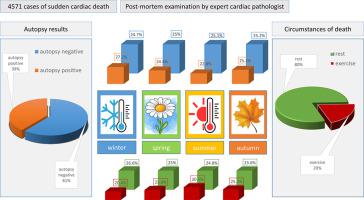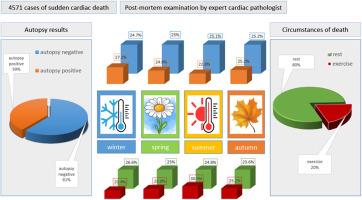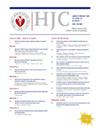心脏性猝死的季节性变化:来自英国大型登记处的启示
IF 3
3区 医学
Q2 CARDIAC & CARDIOVASCULAR SYSTEMS
引用次数: 0
摘要
背景心脏性猝死(SCD)比较常见,可能发生在表面健康的人身上。人们对季节性变化作为 SCD 风险因素的作用知之甚少。本研究的目的是调查 SCD 是否表现出对特定季节的偏爱。方法我们回顾了 2000 年至 2018 年期间转诊至伦敦圣乔治大学心脏病理中心的 4751 例 SCD(平均年龄为 38 ± 17 岁)的数据库。临床信息来自转诊的验尸官,他们被要求填写一份详细的调查问卷。所有病例均由心脏病理专家对心脏进行了宏观和组织学评估。结果SCD在冬季较常见(26%),夏季较罕见(24%),P= 0.161。在心脏结构正常的心律失常性猝死综合征(SADS,2910 例)病例中,未观察到明显的季节性变化。相比之下,在尸检时发现心脏结构异常的死者(1841 人)中,季节分布有明显差异。在这一分组中,冬季(27%)发生 SCD 的频率高于夏季(22%)(P=0.007)。结论虽然 SADS 全年发生,没有季节性变化,但结构性心脏病导致的 SCD 似乎在冬季更为常见。生物气象因素可能是潜在结构性心脏病患者发生 SCD 的潜在诱因。本文章由计算机程序翻译,如有差异,请以英文原文为准。


Seasonal Variation in Sudden Cardiac Death: Insights from a Large United Kingdom Registry
Background
Sudden cardiac death (SCD) is relatively common and may occur in apparently healthy individuals. The role of seasonal variation as a risk factor for SCD is poorly understood. The aim of this study was to investigate whether SCD exhibits a predilection for specific seasons.
Methods
We reviewed a database of 4751 cases of SCD (mean age 38 ± 17 years) referred to our Center for Cardiac Pathology at St George’s University of London between 2000 and 2018. Clinical information was obtained from referring coroners who were asked to complete a detailed questionnaire. All cases underwent macroscopic and histological evaluation of the heart, by expert cardiac pathologists.
Results
SCD was more common during winter (26%) and rarer during summer (24%), p = 0.161. Significant seasonal variation was not observed among cases of sudden arrhythmic death syndrome (SADS, 2910 cases) in which the heart is structurally normal. In contrast, a significant difference in seasonal distribution among decedents exhibiting cardiac structural abnormalities at the post-mortem examination (n = 1841) was observed. In this subgroup, SCDs occurred more frequently during winter (27 %) compared to summer (22%) (p = 0.007). In cases diagnosed with a myocardial disease (n = 1399), SCD was most common during the winter (27%) and least common during the summer (22%) (p = 0.027).
Conclusions
While SADS occurs throughout the year with no seasonal variation, SCD due to structural heart disease appears to be more common during the winter. Bio-meteorological factors may be potential triggers of SCD in individuals with an underlying structural cardiac abnormality.
求助全文
通过发布文献求助,成功后即可免费获取论文全文。
去求助
来源期刊

Hellenic Journal of Cardiology
CARDIAC & CARDIOVASCULAR SYSTEMS-
CiteScore
4.90
自引率
7.30%
发文量
86
审稿时长
56 days
期刊介绍:
The Hellenic Journal of Cardiology (International Edition, ISSN 1109-9666) is the official journal of the Hellenic Society of Cardiology and aims to publish high-quality articles on all aspects of cardiovascular medicine. A primary goal is to publish in each issue a number of original articles related to clinical and basic research. Many of these will be accompanied by invited editorial comments.
Hot topics, such as molecular cardiology, and innovative cardiac imaging and electrophysiological mapping techniques, will appear frequently in the journal in the form of invited expert articles or special reports. The Editorial Committee also attaches great importance to subjects related to continuing medical education, the implementation of guidelines and cost effectiveness in cardiology.
 求助内容:
求助内容: 应助结果提醒方式:
应助结果提醒方式:


